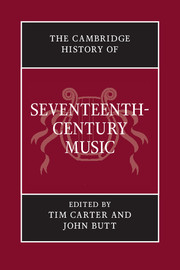Book contents
- Frontmatter
- 1 Renaissance, Mannerism, Baroque
- 2 The seventeenth-century musical ‘work’
- 3 Music in the market-place
- 4 Music in new worlds
- 5 Music and the arts
- 6 Music and the sciences
- 7 The search for musical meaning
- 8 Power and display: music in court theatre
- 9 Mask and illusion: Italian opera after 1637
- 10 The Church Triumphant: music in the liturgy
- 11 Devotion, piety and commemoration: sacred songs and oratorios
- 12 Image and eloquence: secular song
- 13 Fantasy and craft: the solo instrumentalist
- 14 Form and gesture: canzona, sonata and concerto
- Appendix I Chronology
- Appendix II Places and institutions
- Appendix III Personalia
- Index
- References
8 - Power and display: music in court theatre
Published online by Cambridge University Press: 28 March 2008
- Frontmatter
- 1 Renaissance, Mannerism, Baroque
- 2 The seventeenth-century musical ‘work’
- 3 Music in the market-place
- 4 Music in new worlds
- 5 Music and the arts
- 6 Music and the sciences
- 7 The search for musical meaning
- 8 Power and display: music in court theatre
- 9 Mask and illusion: Italian opera after 1637
- 10 The Church Triumphant: music in the liturgy
- 11 Devotion, piety and commemoration: sacred songs and oratorios
- 12 Image and eloquence: secular song
- 13 Fantasy and craft: the solo instrumentalist
- 14 Form and gesture: canzona, sonata and concerto
- Appendix I Chronology
- Appendix II Places and institutions
- Appendix III Personalia
- Index
- References
Summary
The seventeenth century inherited a well-established tradition of magnificent courtly spectacle. For centuries, European rulers had celebrated special occasions with feasts, tournaments and jousts, and parade-like entries into their domains, all involving spectacular decoration, costume and pageantry. By the latter part of the sixteenth century, particularly under the influence of the Medici court in Florence, such events had developed a vocabulary and set of values that reflected both the Humanist spirit of the age and the growing notion of the prince as the repository of absolute power. From these elements came important new theatrical genres in which music played a central part.
The Medici, and those who emulated them, regarded magnificence as a princely virtue. Lavish spending on building projects and artworks served the state by displaying the monarch’s power and prestige. Moreover, the arts had a special ability to express the court’s values and confirm the importance of politically significant events. Theatrical spectacles brought the arts together. According to the Neoplatonic ideals of the era, poetry, music, dance, painting and architecture, working in harmony, were thought to reflect in microcosm the orderly harmony of the universe, recreated here on earth under the wise and virtuous rule of the prince. Theatrical entertainments were thus an important part of major dynastic celebrations. Though ephemeral, such entertainments were often recorded in lavish detail in commemorative volumes sponsored by the court; the music, too, might sometimes be published. Those who were not privileged to attend could thus experience the event vicariously, in all its magnificence.
- Type
- Chapter
- Information
- The Cambridge History of Seventeenth-Century Music , pp. 197 - 240Publisher: Cambridge University PressPrint publication year: 2005
References
- 1
- Cited by



